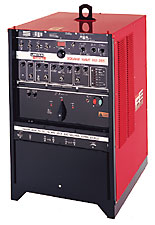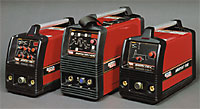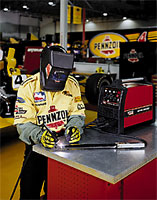Inverter Based Power Sources for Welding Aluminum
The world is changing. That's no surprise to anyone who is even remotely conscious of their surroundings. However, it's tempting to look at long- established technologies, such as welding, and believe that there is little or no technology development taking place at this late date. However, the person who took that view would be wrong. In fact, the design and capabilities of welding power supplies has changed and is continuing to change, rapidly. One of the technologies driving this change is the development and popularization of power supplies based on inverter technology. This technology is particularly well suited to welding aluminum alloys, especially thin aluminum alloys.
What's New?
In the past, welding power supplies have been based on transformers. The power supply took in 60 Hertz 230, 460 or 575 volt power. A metallic transformer changed it from the relatively high input voltage to 60 Hertz current at a lower voltage. This low voltage current was then rectified by some sort of rectifier bridge to get direct current (DC) welding output. Control of this output was usually performed by some sort of relatively slow magnetic amplifiers.
Transformer based TIG welders are typically heavy and large. Transformers are relatively inefficient operating at 50 or 60 Hertz. A lot of heat is generated in the transformer, and the transformer must be relatively large and heavy. A significant part of the power cost goes into heating the transformer and the surrounding air. Most such welding power supplies weigh around 400 pounds and have a shape something like a 32 inch cube. Additionally, if 60 Hertz is used, control signals are limited to being issued at no more than 120 per second, so it's impossible to pulse the welding current any faster than this.
In inverter controlled power supplies, the same incoming 60 Hertz power is used. However, instead of being fed directly into a transformer, it is first rectified to 60 Hertz DC. Then it is fed into the inverter section of the power supply where it is switched on and off by solid state switches at frequencies as high as 20,000 Hertz. This pulsed, high voltage , high frequency DC is then fed to the main power transformer, where it is transformed into low voltage 20,000 Hertz DC suitable for welding. Finally it is put through a filtering and rectifying circuit . Output control is performed by solid state controls which modulate the switching rate of the switching transistors.
What advantages does this new inverter controlled design offer? First, the main power transformer, which operates at 20,000Hertz is vastly more efficient than 60Hertz transformers, which means it can be much smaller. Remember, transformer - based machines typically weigh 400 pounds plus and are a 32 inch cube. The accompanying photo shows the Lincoln line of inverter - based gas tungsten arc welding (GTAW) power supplies. The machine in the center, the V205, weighs 33 pounds and is 9 inches wide, 19 inches deep and 15 inches high. The other two machines are DC only inverters and are even lighter and smaller. So there is a huge advantage in weight and portability in favor of the inverter - based machines.
There is another advantage of the inverter power supplies - power cost. The inverter equipment is much more efficient than transformer equipment. For instance, the current draw at 205 amperes for the Lincoln V205 is 29 amperes on 230Volt single phase power. The current draw of an older transformer welder is typically 50 to 60 amperes on 230 Volt single phase power when welding at similar currents. While the cost savings in switching to inverters is often overstated, under normal circumstances, it is safe to say that annual power savings are approximately 10% of the power supply purchase price.
The other significant advantage of inverter power supplies is that, by "choppingup" the incoming AC so finely, we end up with a very steady DC, without the typical 60 Hertz ripple. This results in a much smoother, more stable DC welding arc.
So far, we've only discussed inverters that supply direct current. For quite a few years, this was all that was available. Inverters that supplied AC output simply did not exist. Then, someone had the idea of packaging two inverters inside one case. By having them run at different polarities and alternately switching them on and off, a pseudo AC output was generated. Some inverters still generate AC in this manner. There are also more sophisticated methods of generating AC today, but for the purposes of this article, it's easier to think of generating the AC from two inverters at opposite polarities.
The ability to generate AC is what really makes the inverter shine for welding aluminum using GTAW. The fact that the arc voltage never truly goes through zero means that the AC arc is much more stable than previously. Most inverter - based GTAW power supplies do not need the high frequency to be on continuously for stability. In fact, the Lincoln V205 has no provision for using continuous high frequency. It will automatically be extinguished as soon as the arc starts.. The elimination of continuous high frequency drastically reduces the amount of RFI generated by the power supply.
Second, the fact that we can send control signals at 20 kilohertz means that we can vary the frequency of the AC welding output. Older machines were 60 Hertz AC output only. The V205 can put out AC at anywhere 20 and 150 Hertz. Higher frequencies can be beneficial in welding thin materials. As the frequency is raised, the arc cone, and the weld, become narrower, resulting in deeper penetration.
It was realized many years ago that in GTAW, weld penetration comes from the electrode negative part of the AC cycle. During the part of the cycle when the electrode is positive, weld penetration is reduced and more heat goes into the tungsten electrode. However, during the electrode positive part of the cycle, the arc actually acts to remove the oxides from the surface of the aluminum, making welding easier. It is for this reason that, although most other materials are GTA welded using direct current, aluminum is usually welded using AC. Very early GTAW power supplies supplied a simple sine wave output where equal amounts of electrode positive and electrode negative were generated. However, this was inefficient. We didn't need that much electrode positive to get adequate cleaning. Later power supplies allowed us to vary the proportion of electrode negative to electrode positive. It was found that approximately 65% electrode negative and 35% electrode positive gave adequate arc cleaning and good penetration. However, a lot of the arc energy was still going to heat the tungsten electrode., so that large diameter tungsten electrodes were required.
The inverter power supplies provide adequate arc cleaning with as little as 15% electrode positive. Reducing the amount of electrode positive makes the process more efficient, increases weld penetration, and reduces the amount of heat going into the tungsten electrode, which means smaller diameter, pointed electrodes can be used. This further concentrates and narrows the weld.
Finally, the newer inverter power supplies are software programmable. This makes it much easier to change power supply characteristics. The accompanying photo shows another Lincoln power supply, the Invertec® V350 Pro. This power supply is primarily designed as an inverter - based machine for gas metal arc welding (GMAW). It contains quite a number of different programs for steady state, pulsed GMAW and non - traditional control algorithms for GMAW. A good number of the pulsed GMAW programs where the pulsing parameters are optimized for specific filler materials and wire sizes. However, because of the software programming, it is also ready to use as a power supply for shielded metal arc welding or gas tungsten arc welding. It can also be reprogrammed in the field in a short time. Along with all of this, the power supply weighs 79 pounds and can put out as much as 425 amperes.
The future is here.



